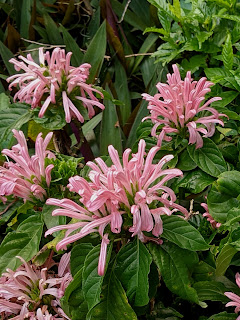If only I'd known about the shade deal when I planted it! In 2007, I sited it on the se facing back wall of our large shed. It was bleached and miserable for years. For the past few years it's been shaded by an elderberry, an avocado, a volunteer Simpson's Stopper, draped by the natives Coral honeysuckle and Virginia creeper. I finally saw many plants at Kanapaha Botanical Garden, growing in varying degrees of shade but all happier than ours. A lightbulb went off! Anyway, as I used to tell design clients, "shade happens", and it happened to us and the Firespike is happy.
One in Adelphi, Maryland, one in Wildwood, Florida, one at the US National Arboretum with a grandfatherly interest in many more around the DC area (unless noted, pictures are taken the day of post)
Tuesday, August 15, 2023
Odontonema strictum, Mexican Fire Spike: hot color in the shade
If only I'd known about the shade deal when I planted it! In 2007, I sited it on the se facing back wall of our large shed. It was bleached and miserable for years. For the past few years it's been shaded by an elderberry, an avocado, a volunteer Simpson's Stopper, draped by the natives Coral honeysuckle and Virginia creeper. I finally saw many plants at Kanapaha Botanical Garden, growing in varying degrees of shade but all happier than ours. A lightbulb went off! Anyway, as I used to tell design clients, "shade happens", and it happened to us and the Firespike is happy.
Sunday, August 13, 2023
Brazilian Plume, Justicia carnea loves the heat
It actually is native to Brazil, an evergreen in warmer places than Central Florida. For us, in USDA zone 9a, it gets very unhappy in the winter, enjoying neither cold (lows occasionally at or a bit below freezing) nor drought. It barely rains from November to June. When the rains return though, and temperatures push into the 80's and 90's, new leaves cover the plant and it flowers. Ours flowers, usually three times a year.
I read that it's an evergreen that it reaches five feet tall with large leaves. In four years, ours is staying about two feet tall, mostly defoliates every winter, and has never had leaves more than two inches long. That size works for us as it stays nicely below the screen porch windows.
Despite preferring ideally warmer temperatures than ours, I grew it successfully in zone 7a just north of the Washington DC. It died to the ground in winter but came back in late spring until finally succumbing to a severe cold spell.

